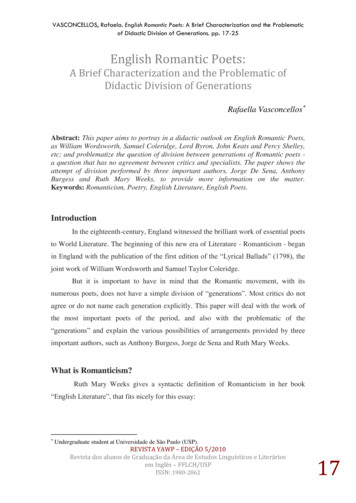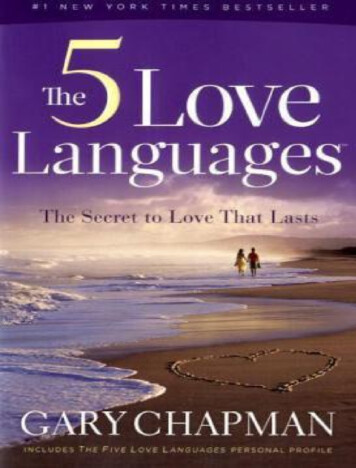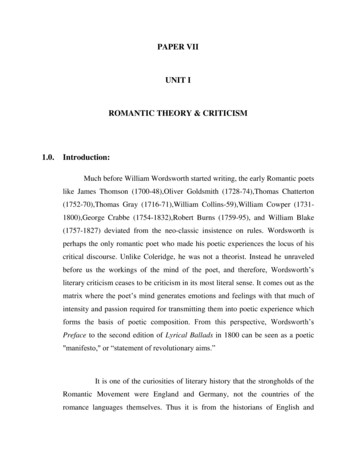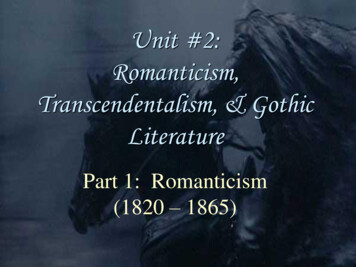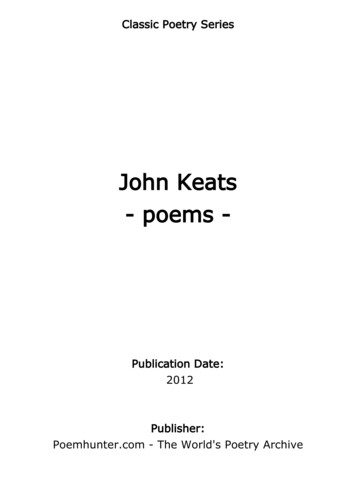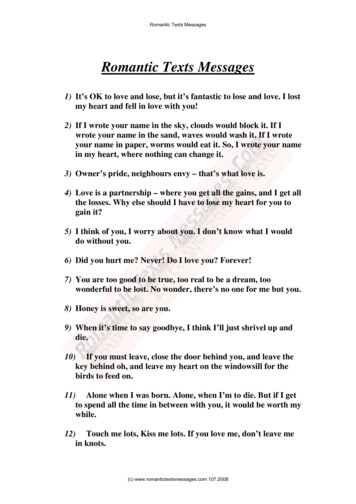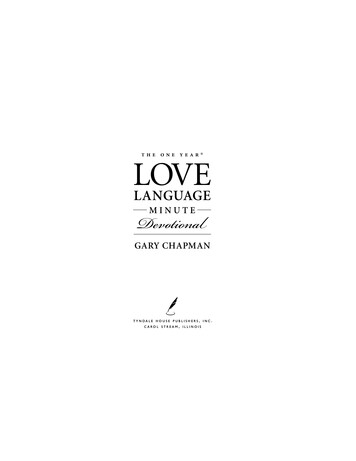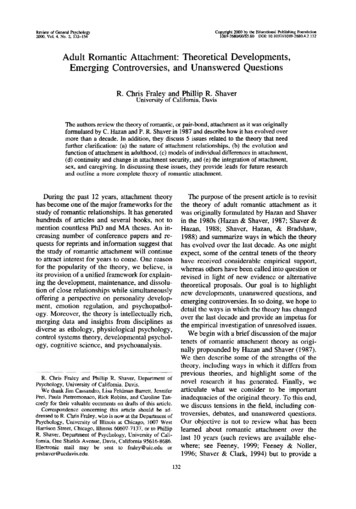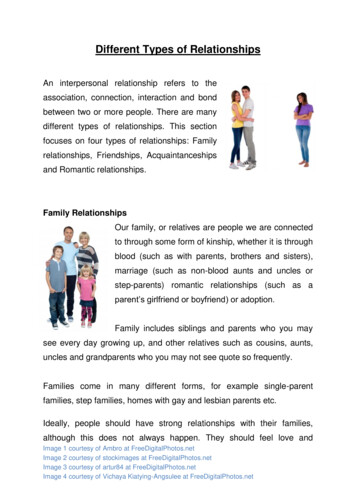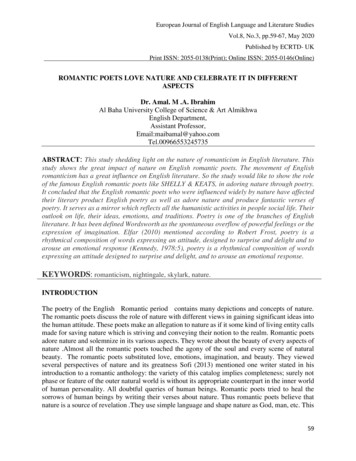
Transcription
European Journal of English Language and Literature StudiesVol.8, No.3, pp.59-67, May 2020Published by ECRTD- UKPrint ISSN: 2055-0138(Print); Online ISSN: 2055-0146(Online)ROMANTIC POETS LOVE NATURE AND CELEBRATE IT IN DIFFERENTASPECTSDr. Amal. M .A. IbrahimAl Baha University College of Science & Art AlmikhwaEnglish Department,Assistant 35ABSTRACT: This study shedding light on the nature of romanticism in English literature. Thisstudy shows the great impact of nature on English romantic poets. The movement of Englishromanticism has a great influence on English literature. So the study would like to show the roleof the famous English romantic poets like SHELLY & KEATS, in adoring nature through poetry.It concluded that the English romantic poets who were influenced widely by nature have affectedtheir literary product English poetry as well as adore nature and produce fantastic verses ofpoetry. It serves as a mirror which reflects all the humanistic activities in people social life. Theiroutlook on life, their ideas, emotions, and traditions. Poetry is one of the branches of Englishliterature. It has been defined Wordsworth as the spontaneous overflow of powerful feelings or theexpression of imagination. Elfar (2010) mentioned according to Robert Frost, poetry is arhythmical composition of words expressing an attitude, designed to surprise and delight and toarouse an emotional response (Kennedy, 1978:5), poetry is a rhythmical composition of wordsexpressing an attitude designed to surprise and delight, and to arouse an emotional response.KEYWORDS: romanticism, nightingale, skylark, nature.INTRODUCTIONThe poetry of the English Romantic period contains many depictions and concepts of nature.The romantic poets discuss the role of nature with different views in gaining significant ideas intothe human attitude. These poets make an allegation to nature as if it some kind of living entity callsmade for saving nature which is striving and conveying their notion to the realm. Romantic poetsadore nature and solemnize in its various aspects. They wrote about the beauty of every aspects ofnature .Almost all the romantic poets touched the agony of the soul and every scene of naturalbeauty. The romantic poets substituted love, emotions, imagination, and beauty. They viewedseveral perspectives of nature and its greatness Sofi (2013) mentioned one writer stated in hisintroduction to a romantic anthology: the variety of this catalog implies completeness; surely notphase or feature of the outer natural world is without its appropriate counterpart in the inner worldof human personality. All doubtful queries of human beings. Romantic poets tried to heal thesorrows of human beings by writing their verses about nature. Thus romantic poets believe thatnature is a source of revelation .They use simple language and shape nature as God, man, etc. This59
European Journal of English Language and Literature StudiesVol.8, No.3, pp.59-67, May 2020Published by ECRTD- UKPrint ISSN: 2055-0138(Print); Online ISSN: 2055-0146(Online)paper focuses on two of the prominent poets and on how they have loved nature and celebrate inits different aspects.The poetry of English Romantic poetry contains many sceneries and notion of nature. Accordingto Lovejoy (1975) most poets of the Romantic era discuss in varying depth, the function of naturein earning significant vision into the human position. The romantic poets believe nature as if itsome kind of living survival calls made for nature to release the conflict and carry their ideaswidely. Romantic poets adore nature and enjoy in its different aspects. Romantic’s poets focus onthe spook of nature in art and language and the observation of dignity through a connection withnature. Venkataraman (2015) asserted that nature gives Rousseau who was one of romanticsingularly beautiful objects to focus on, which helps keep his imagination from focusing on hisdifficulties and worsening his emotional state. Since Rousseau has often spent the most enjoyableperiods of his life in the proximity of nature, the objects of nature also generate memories ofhappier times for him. But for a man with as avid an imagination as Rousseau, it could hardly bethe case that nature keeps him from completely avoiding painful memories. He helped to flattenthe way for future romantic periods likes Edgar Allen Poe, William Blake John Keats, etc.The romantic poets touched the agony of every spirit and every sight of natural beauty. Theromantic’s poets’ substituted love, emotions, imagination, and beauty. They tried to heal thesorrows of human beings by writing their verses about nature. I believe that romantic poets seethat nature is a precursor of revelation. They employ natural language and impersonate nature asGod, man, etc. It has also been associated with acknowledgment and remoteness from everydaylife the study will attempt to account point of view of romanticism in Keats poetry to show howthis concept of 'romanticism' is somewhat shorten when applied to the poetry of Keats. Accordingto Prickett (1981) mentioned that the Romantic Era extended roughly between 1798 and 1832and its poetry places a stress on the fancy, nature, and feeling. Romanticism protrudes out of theintellectual thinking of the Enlightenment Era into a healing and inspiring period. John Keats wasborn at the beginning of Romanticism making him an eminent figure in the expression of theseworthy values. Many questions are asked by John Keats about nature, existence, eternal love anddeath. This is sketched through the use of personification, “When I behold, upon the night’s starr’dface, Huge cloudy symbols of a high romance”, where Keats turns to nature giving the night sky ahuman quality. "Percy Shelly is one of Romantic poets, Shelley, was an ardent lover of Nature.Like Wordsworth, Shelley visualizes nature as one soul, the superior power working through allthings. “The one spirit’s plastic stress/ Sweeps through the dull dense world.” Again he shapedeach object of nature as individual life, a part of that superior power, Nature. He solemnizes naturein most of his poems as his main theme such as The Cloud, To a Skylark, To the Moon, Ode to theWest Wind, A Dream of the Unknown. SULT AND DISCUSSIONJohn Keats is one of the paramount poets who love and adore nature. He expresses the beauty ofboth real and imaginative shapes of nature. Everything in nature for him is full of marvel andmystery-the rising sun, the moving cloud, the growing bud and the swimming fish. His love for60
European Journal of English Language and Literature StudiesVol.8, No.3, pp.59-67, May 2020Published by ECRTD- UKPrint ISSN: 2055-0138(Print); Online ISSN: 2055-0146(Online)nature is purely gratifying and he loves the beautiful scenes and insight of nature for their ownsake. Keats believes that the reality of existence can be seen in nature and he wants to live in orderto find reality and search and testify these answers for himself. He also symbolizes romance in theclouds and the face of the starry night which again reflects the values of romanticism and the viewthat the purest translation of life lies within the natural world itself. An Essay (2019) mentionedthat “High romance” represents the ancient symbol for ultimate questions in life and Keats searchfor value and concept in nature in order to form these answers himself He believes that "A thing ofbeauty is a joy forever'. He looks with child-like delight at the items of nature. In his poem odeto a Nightingale, he writes:My heart aches, and a drowsy numbness painsmy sense, as though of hemlock I had drunkOr emptied some dull opiate to the drainsWhile John Keats was seeing the nightingale he was stunned him before hearing of the song of thebird, he tried many methods to forget his anxieties. Shrestha, Roma (2013) said Keats believed hehas either been intoxicated or is affected by the drug. But Keats felt a calm and lasting glee in thesong of Nightingale which makes him completely happy. It indicates to enclose with nature giveseverlasting cheerfulness for the people. Nature acts as a source of making happiness and is the bestleader for people to live a merry life. In the beginning, Keats seems to be an immature youth witha gloomy heart insist to find a means of solace and fleeing. On catching the sight of a nightingaleand hearing its music, which he assumes to be an undying sound of happiness, Keats feels that hisbody is getting narcotic. But, he also feels a severe pain because he is aware of his death and pain.He imagines of having drunk hemlock or 'some dull opiate':"My heart aches, and drowsy numbness pains,my sense, as though of hemlock I had drunk.Using of birds by two romantic poets is a fascinated thing. John Keats listened to a nightingalesong and awarded us with his Ode to a Nightingale. The sky-lark inspires Percy Shelley andthrough his vision of the bird, we are appraised to its gracefulness. Birds have always caughtprominence in human lives. While some animals have many roles in human lives they werecompanions, others for labor or a source of food, our flying birds' companions' held anotherworldly place. Birds flew and sang in heights which cannot be carried out by humans. Thesetwo romantic poets use a bird as their inspiration and also a model for the human experience. Ithas also been associated with delivery and remoteness from everyday life the study will attempt toaccount the perspective of romanticism in Keats poetry to show how this notion of 'romanticism'is somewhat limiting when applied to the poetry of Keats. Asnes (2019) cited the romantic eraspanned roughly between 1798 and 1832 and its poetry places an emphasis on the imagination,nature, and feeling. Romanticism protrudes out of the logical idea of the Enlightenment Era intoa redemptive and thrilling period. John Keats was born at the beginning of Romanticism makinghim a significant figure in the expression of these values. His poetry was a great example of theRomantic era and his poems; “When I have fears that I may cease to be” and “Bright star” reflectedall of the major concepts of the Romantic period. John Keats has celebrated the significances ofRomanticism rigorously in the poem “When I have fears that I may cease to be “. In this poem,Keats's reaction against the logical idea is uttered into realization in nature and fantasy. John Keats61
European Journal of English Language and Literature StudiesVol.8, No.3, pp.59-67, May 2020Published by ECRTD- UKPrint ISSN: 2055-0138(Print); Online ISSN: 2055-0146(Online)seeking responses to queries in nature about presences, immortal love and death. This is portrayedthrough the use of personification, “When I behold, upon the night’s starr’d face, Huge cloudysymbols of a high romance”, where Keats turns to nature giving the night sky a human quality.Keats suggests that the truth about existence can be observed in nature and he wants to live inorder to find the truth and search and witness these answers for himself. He also symbolizesromance in the clouds and the face of the starry night which again reflects the values ofRomanticism and the view that the purest translation of life lies within the natural world -s-poetry-reflect-the-romantic-era/“High romance”represents the ancient symbol for final queries in life and Keats search for importance and conceptin nature in order to form these queries themselves.Keats is one of the greatest fond and swain of nature. He expresses the beauty of both real andartistic forms of nature. Everything in nature for him is full of wonder and mystery-the rising sun,the moving cloud, the growing bud and the swimming fish. His love for nature is purelysensuousness and he loves the beautiful scenes of nature for their own sake. He believes that "Athing of beauty is a joy forever'. He looks with child-like delight at the objects of nature. Thischaracteristic consider to be one of the characteristics of romantic poetry. In his poem ode to aNightingale, he writes:My heart aches, and a drowsy numbness painsmy sense, as though of hemlock I had drunkOr emptied some dull opiate to the drainsThe initial situation of awareness and conflict is slowly to change and develop throughout the odewith a corresponding shift in tone. The tragic awareness of suffering wrenches on him a strangekind of a pain because the protesting effect of sluggishness which is the effect of desire isincreasing. The awareness is a burden that makes him 'sunk' gradually towards the world ofoblivion. The poem expresses the poet's love of romance, deep delight in nature and how hecelebrated nature in various dimension .The poem contains concrete imagery, the richness ofcoloring and the elements of charm and deep human interest which show the nature. The masteryof poetic language is perfectly seen in the poem and the expressions are unsurpassed. According toMukesh Kumar (2014) Keats was a pure poet; his vision of the beauty was never distorted by the theories. Hisconcept of negative capability implies the ability to perceive, think without any presuppositions.Keats succeeded in choosing this bird Nightingales to celebrate his nature. Nightingales are namedso because they frequently sing at night as well as during the day. The name has been used for wellover 1,000 years, being highly recognizable even in its Anglo-Saxon form - Nightingale'. It means'night songstress'. Patterson library Westfield, New York case 10 .Their song is loud, with animpressive range of whistles, trills and gurgles. Their songs is particularly noticeable at nightbecause few other birds are singing. This is why its name (in several languages) includes "night".Only unpaired males sing regularly at night, and nocturnal song is likely to serve attracting a mate.Singing at dawn, during the hour before sunrise, is assumed to be important in defending the bird'sterritory. Nightingales sing even more loudly in urban or near-urban environments, in order toovercome the background noise. The most characteristic feature of the song is a loud whistling62
European Journal of English Language and Literature StudiesVol.8, No.3, pp.59-67, May 2020Published by ECRTD- UKPrint ISSN: 2055-0138(Print); Online ISSN: 2055-0146(Online)crescendo, absent from the song of thrush nightingale. It has a frog-like alarm call. I believe thecalm of dawn usually purified our soul and Sentiments was disengaged from it. So Nightingaleinspired the poet and blew his feelings and sensation and unleashed them in space and theninterpreted them into utterance coordinated in a unique sequencing represented by the poet in hispoem Ode to Nightingale.Percy Bysshe Shelley (/ˈpɜrsi ˈbɪʃ ˈʃɛli/) was born in 1792, and was the master poet of EnglishRomantic era and is believed as a lyrical poet of English language by the great scholars and critics.Shelley has a special view about beauty and he expresses his perspective about it in poems like"To a Skylark" and "Ode to the West Wind", that in them he uses such metaphors from nature andmakes a relationship between his feeling and art. Poetry is a convenient technique of dilatingimagination and caprice, and fantasy is the real origin of sympathy, emotion dote, and sympathy,which is pauper on the ability of someone exciting another's one. Shelley, himself debates that: "Aman, to be greatly good, must imagine intensely and comprehensively; he must put himself in theplace of another and of many others. The agony and cheering of his type must become his own.The great machine of ethical good is the fantasy, and poetry administers to the impact by actingupon the occasion.In his handling of nature, he describes the things in nature as they are and never colors them. It istrue, he gives them the characteristics of human life through his personifications, but he does itaccidentally for he felt they are human beings who able of doing the duty of human beings. Hismythopoeic power had made him the best romanticist of his age. In Ode to the West Wind, hepersonifies Nature as the Destroyer and the Preserver, and in the Cloud, the cloud is a possessorof mighty powers. He also believed in the healing aspect of Nature and this is revealed in hisEuganean Hills in which he is healed and soothed by the natural scene around him and also theimaginary island. In The Recollection the same idea of the healing power of Nature is applied.Shelley’s revolutionary zeal in ode “To Skylark”. According to Shelley, the bird, Skylark, sentoff spontaneous melody from heaven and elicit higher and higher can never be a bird. It is for thepoet, a joyful spirit that begins its upward flight at sunrise and becomes invisible at the eveninglike the stars of the sky that become invisible in daylight. In addition, it is compared with the beansof the moon whose presence is rather felt than seen. It's a paradise bird and by singing it spreadsits influence through the world.In the opening stanza, the bind is seen as a "blithe spirit" that"Pourest thy full heart/In profuse strains of unpremeditated art."The words "Pourest thy full heart"It means that the bird pours out its heart in song and with "In profuse strains of unpremeditatedart", Shelley refers to the spontaneous flow of music which comes from the Skylark. There isnothing synthetic in its music, it overflows richly from its heart. And Shelley says as a soul ofrevolution it propagates its rebellious message as the moon spreads its beam. He says,63
European Journal of English Language and Literature StudiesVol.8, No.3, pp.59-67, May 2020Published by ECRTD- UKPrint ISSN: 2055-0138(Print); Online ISSN: 2055-0146(Online)"All the earth and airWith thy voice is loud,As, when might is bare,From one lonely cloudThe moon rains our her beams, and Heaven is overflowed.As at the beginning of the poem, the poet says the bird is a heavenly bird and it is a joyful spirit,its life is not sorrowful like that of the human being. The life of human beings is full of sadness,suffering and it is scarcely to find glee without pain. Our happiness is often portrayed by memoriesof part passion and sorrows, and the painful uncertainty of what is to come in the future. Man is acreature that looks "before and after". He is subject to fatigue and satiety so that he can never enjoyhappiness eternally. But the Skylark knows on satiety. It is the very embodiment of perennialdelight, ever fresh and full of the west and unwearied in its enjoyment of happiness. Human life,on the other hand, is subject to recurrent spells of frustration and pain. As he says,“We look before and after,And shoe for what is not:Our sincerest laughterWith some pain is fraught:Our sweetest songs are those that tell of saddest thought."So the poet wants to experience half the jovial of the bird and them he would sing with suchexcellent poetic ecstasy via the people of the world listen to him. He says"Teach me half the gladnessThat thy brain must know,Such harmonious madnessFrom my lips would flowThe world should listen then-as I am listening now."Shelley thus asks the skylark to inform him its ideas, compared to which, he believes, humanbeing's wedding songs (‘Chorus Hymeneal’) and hymn of victory would be no more than emptypride The bird seems to be full of happiness set free of those things that weigh down human life.It seems illiterate of pain, sloth, and anger, and must have deeper and truer information of death,‘Or how could thy notes flow in such a Chrystal stream?’ Should the skylark ‘Teach me half thegladness / That thy brain must know’, Shelley writes in the concluding stanza, it would bring himan ‘harmonious madness’ of the kind Plato describes in Phaedrus, which Shelley had read in May1819: (2014) If anyone comes to the gates of poetry and expects to become an adequate poet byacquiring expert knowledge of the subject without the Muses’ madness’, says Socrates, ‘he willfail, and his self-controlled verses will be eclipsed by the poetry of men who have been driven outof their minds.’Burroughs (2013) mentioned in his book that “The bird that occupies the second place to thenightingale in British poetical literature is the skylark” a rustic bird as the Philomel is an64
European Journal of English Language and Literature StudiesVol.8, No.3, pp.59-67, May 2020Published by ECRTD- UKPrint ISSN: 2055-0138(Print); Online ISSN: 2055-0146(Online)arboreal,—a creature of light and air and motion, the companion of the plowman, the shepherd,the harvester,—whose nest is in the stubble and whose trust is in the sky. Its life provides that kindof contrast which the imagination loves,—one moment a plain pedestrian bird, hardlydistinguishable from the ground.The lark's song is not especially tuneful but is blithesome, sibilant, and unceasing. Burroughs(2013) wrote its type is the grass, where the bird makes its home, abounding, multitudinous, thenotes nearly all alike and all in the same key, but rapid, swarming, extravagant, falling down asthick and fast as drops of rain in a summer shower. Many noted poets have chanted the praises ofthe skylark, or been kindled by his example. Shelley's ode “To a Skylark" is well known to allreaders and fond of poetry"Bird of the wilderness,Blithesome and cumberless,Sweet be thy matin o'er moorland and lea!Emblem of happiness,Blest is thy dwelling-place—Oh to abide in the desert with thee!"I heard of an enthusiastic American who went about English fields hunting a lark with Shelley'spoem in his hand, thinking no doubt to use it as a kind of guide-book to the intricacies andharmonies of the song. He reported not having heard any larks, though I have little doubt they weresoaring and singing about him all the time, though of course they did not sing to his ear the songthat Shelley heard. The poets are the best natural historians, only you must know how to read them.They translate the facts largely and freely. John Burrough(2013) A celebrated lady once said toTurner, "I confess I cannot see in nature what you do." "Ah, madam," said the complacent artist,"don't you wish you could!"Shelley's poem is perhaps the best known and has a higher outstanding among literary nation morethan Wordsworth's; the skylark inspired shelly also the same as the Nightingale who inspired KeatsShelley knows that his skylark is merely a bird with a song that, to the human ear, sounds like ahappy song. He is indulging in infancy and has no intention whatever of deceiving the reader orhimself. The exquisite happiness that his ear has heard in the song of the nightingale has carriedhim away. In the last stanza of the poem, he claims to the creature of his fantasy to prompt himhalf the happiness "that thy brain must know." gladness is the mystery of the elegant song of theskylark; if Shelley possessed only half of the "gladness" of the skylark, he could write poetry thatthe world would read with the same absorbed in awareness he is giving to the song of the skylarkthat his ears discerned.CONCLUSIONRomanticism in context has been a measure to explain the poetry of the Romantics as a whole andthe visible depiction s in Keats’s Ode to a Nightingale and Shelley’s Skylark in particular. Theimagery used in their poems will not be understood without Keats’s poetic rules discussed in his65
European Journal of English Language and Literature StudiesVol.8, No.3, pp.59-67, May 2020Published by ECRTD- UKPrint ISSN: 2055-0138(Print); Online ISSN: 2055-0146(Online)odes and Shelley’s Defense of Poetry and poems. Their poetic devices like metaphors andpersonification of the two birds Nightingale and skylark in their poems have been used tosymbolize their revelation and their notion of celebrating on the truth of their age at large and ontheir individual lives as a poet in particular. This comparative study of the two poets in particularand how they adore Romanticism through nature as a whole and has managed some of their versesto clarify their poetic principles in concept and application. Their poetry and concept of fantasyhave affected the poetry of their era and probably for many generations to come. Romanticism hasalways been an essential interest for many critics and scholars of literature over the world .Thesetwo romantic poets have tried their best to bring gladness to mankind and dispose of all theirsadness through natural beauty and pastoral settings in their poetry. They believed that nature hasan answer for all unanswered questions. They celebrate and adore the beauty of nature in itsdifferent aspects. To sum up nature is the origin of revelation that leads romantic poets and peopleto a delighted, optimistic and prosperous life.References1. Asnes, Tania. Berkow, Jordan ed. "The Rime of the Ancient Mariner The Romantics".GradeSaver, 24 June 2006 Web. 11 December 20192.Arthur O. Lovejoy expounds on the near meaning essences of the word 'romantic" in his essay'On the Discrimination of Romanticisms' in English Romantic Poets M.H. Abrams (ed.) (OxfordUniversity Press, 1975), pp. 3-23.3. BirdLife International (2004). Luscinia megarhynchos. 2006 IUCN Red List of ThreatenedSpecies. IUCN 2006. Retrieved on 12 May 2006. Database entry includes justification for why thisspecies is of least concern4. Dr.A.Chandra Bose," Generating Happiness through Nature by Romantic poets”, ResearchJournal of English Language and Literature (RJELAL), vol.1.Issue.3, 2013.5. John Burroughs () 2013 Birds And Poets with Other Papers Produced by Produced by JackEden, and David Widger6. Nasser ud-din sofiIOSR Journal Of Humanities And Social Science (IOSR-JHSS) Volume 17,Issue 6 (Nov. -Dec. 2013), PP 81-83e-ISSN: 2279-0837, p-ISSN: 22790845.www.iosrjournals.org.7.Phaedrus, 245b; translated by A. Nehamas and Paul Woodruff, in Plato: The Complete Works,ed. John M Cooper (Indianapolis, 1997), p. 523.8. Prabhu Venkataraman (2015) Cosmos and History: The Journal of Natural and SocialPhilosophy, ROMANTICISM, NATURE, AND SELFREFLECTION IN ROUSSEAU’SREVERIES OF A SOLITARY WALKER vol. 11, no. 1, 20159. Prickett, S. (1981).”Romantic Literature.” In Stephen P .(ed), The Context of English Literature:The Romantics Lon-don: Methuen and CO., 22010. Rizka Elfira( 2010)The Moral Values In Some Of Robert Frost’s Poems, a Thesis fromUniversity Of Sumatera Utara Medan English Department Faculty Of Letters11. Shrestha, Roma. "Ode to a Nightingale by John Keats: Summary and ngale.html.66
European Journal of English Language and Literature StudiesVol.8, No.3, pp.59-67, May 2020Published by ECRTD- UKPrint ISSN: 2055-0138(Print); Online ISSN: 2055-0146(Online)12. Kumar M (2014). Negative Capability and Poetic Vision. International Journal of the Research Vv-1,pp 2348-6848.67
The romantic poets touched the agony of every spirit and every sight of natural beauty. The romantic’s poets’ substituted love, emotions, imagination, and beauty. They tried to heal the sorrows of human beings by writing their verses about nature. I believe that rom
